Stephanie Triplett
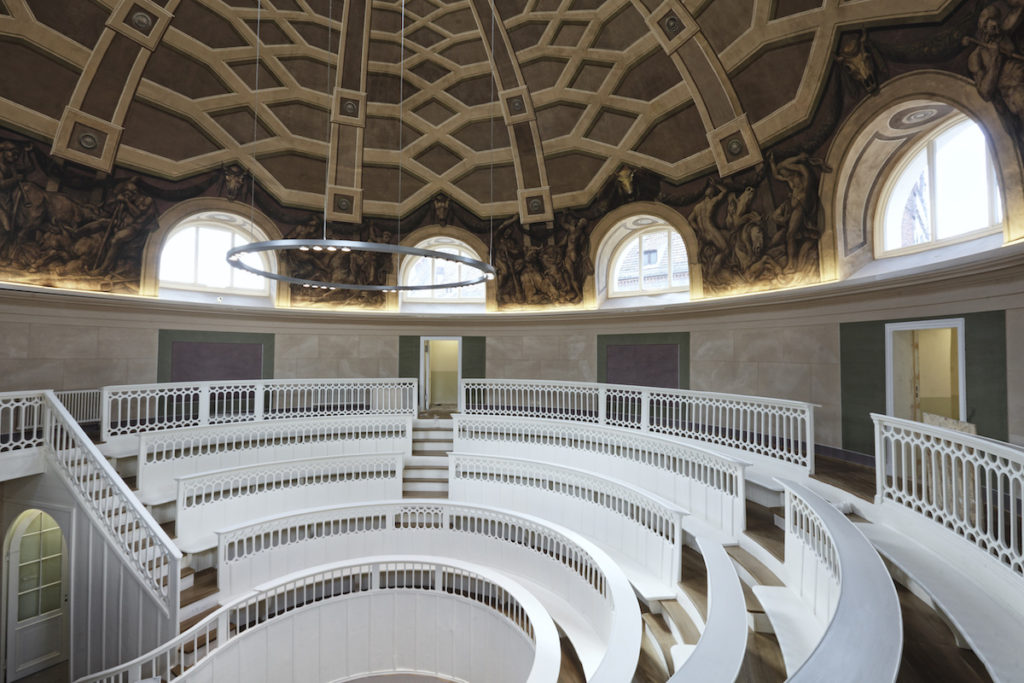
The Tieranatomisches Theater (animal dissection theater) in Berlin designed by Carl Gotthard Langhans (1732-1808) and built in 1790 as part of the newly founded Prussian veterinary school features an elaborate decorative program of trompe l’oeilgrisaille friezes encircling the central dome (Fig. 1). In these frescoes, the commonplace activities of animal culture are situated in a literally and figuratively elevated space of Greco-Roman allegory. Each of the eight narrative panels portrays nude, or lightly draped, pairs of men flanking animal groups arranged by species. These muscular figures prime cavalry horses for battle (Fig. 2) and prepare to kill plague-stricken cattle (Fig. 3). They also participate in more peaceable scenes related to herding animals like goats (Fig. 4), sheep, dogs, and wild boars. In an inversion of the bovine plague scene, they attend the birth of a calf. Designed and executed by Christian Bernhard Rode (1725-1797) in his capacity as head of the Prussian Academy of Art, the frescoes depict veterinarians and farmers as responsible not only for the wellbeing of livestock but also for the health of Prussia’s agriculture, economy and military. Rode thus acknowledged human civilization’s deep dependence on animal labor and byproducts. Despite their striking nature, the Tieranatomisches paintings have received little attention from contemporary art historians, and Rode’s posthumous reputation has suffered in comparison with the fame he enjoyed during his lifetime.
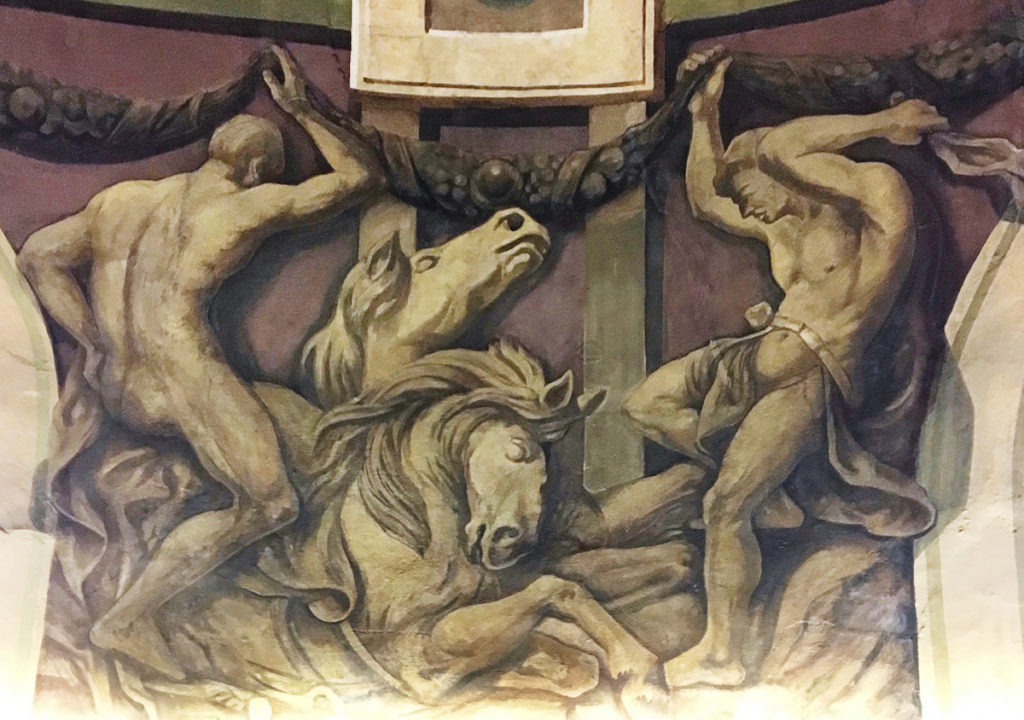
In this short essay, I argue that Rode sanctified the often socially denigrated practices of animal medicine and agriculture through the deployment of antique motifs and an illusionistic ceiling fresco format, while also challenging classical ideals of the preeminence of the human form through its comparison with the animal. Though the men in the panels dominate the beasts in their care, they also coexist with them in a naked, primeval state. The artist thus created a visual equivalence between the human and animal bodies, asserting the comparable status of veterinary science and human medicine. Though human nudes appear prominently in the frescoes, they remain secondary to their animal counterparts, who form the nexus of the dramatic action. Rode’s contemporaries, as well as art historians, have frequently remarked upon his anatomical inaccuracies, making him an unusual choice to decorate a building dedicated to the study of the body.[1] His frescoes preceded the institution of animal anatomy courses and the later development of the narrative animal painting genre in the Germanic states during the mid-nineteenth century.[2] They thus grapple awkwardly with how best to center mammalian subjects in publicly commissioned, neoclassical painting.
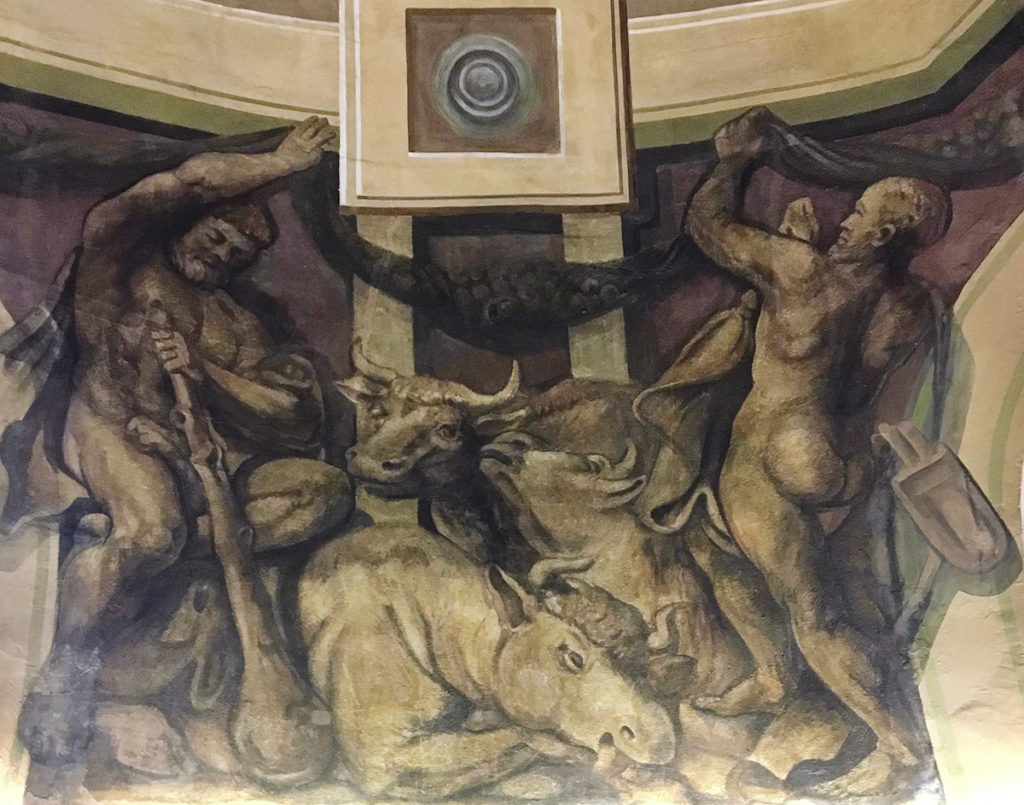
Rather than fully containing the creatures in their space, the male figures co-exist with them in ambiguous relationships of control, care and contagion. The cavalry horses in Fig. 2 are naturally skittish animals; the men whip them with towels to prepare them for the perils of battle. In the fresco, they remain unsaddled and unmounted, implying that they have yet to be fully tamed. The painting thereby unsettles the human sovereignty projected by traditional equestrian portraits of generals and monarchs. The men surrounding the plague-stricken cattle in Fig. 3 appear exhausted in their efforts to contain both the dying animals and uphold the decorative garland. The herded goats in Fig. 4 gather companionably around their shepherds in a nearly familial arrangement. The overall vision that emerges is less one of nature dominated by humanity than of uncertainly maintained relationships, of cross-species struggle and collaboration, including, in the case of the cattle, of a fight against disease-causing agents. As I will discuss below, the veterinary anatomy theater’s construction was initially contested due to the perceived triviality of animal medicine as compared to human treatment. The fresco program, by revealing the nobility, as well as the instability, of human participation in animal culture points to the fundamental importance of the animal to Enlightenment social order: as companion species, foundation of agriculture and military mobility.

The Tieranatomisches figures, in their unruly actions and bodily excesses, deviate from Greco-Roman ideals then in circulation. Johann Joachim Winckelmann (1717-1768), as the preeminent German spokesman of the antique tradition, posited “stillness” and “tranquility” as the essence of artistically rendered beauty, a beauty that he felt had reached its apex in ancient Greek art, particularly sculpture. The perfection of godly figures was manifested through their youthful lack of visible “nerves and tendons,” which functioned as “an expression of divine sufficiency, which has no need for those parts dedicated to nourishing the body.”[3] The immortal bodies that signaled classicism’s greatest achievements seemed to possess none of the organs and structures that formed the dissection theater’s primary object of study. Yet, as Winckelmann noted, each organism had its own correspondent aesthetic appeal, an appeal that he however did not theorize in the case of the bestial form, defined only negatively in relation to the human. According to Winckelmann, the closer a human being’s apparent resemblance to an animal, the more his physical “harmony” and “unity” were disturbed, disturbances that he problematically posited as “deviations” from a white, European physical “norm.”[4]
Indeed, the very act of dissection as then practiced in the Germanic states was premised on distancing its objects from any perceived sense of humanity. Deceased animals could be examined without the same moral qualms that surrounded human dissections, which were, in turn, generally performed on subaltern subjects. Capital punishment victims, suicides and unwed mothers who died in childbirth were among the acceptable sources of dead bodies in eighteenth-century Prussian medicine.[5] The dissected creaturely body, unburdened by Christian concerns around the sanctity of the human form and its burial, could therefore serve the causes of medicine and artistic education with comparatively little controversy. Nonetheless, all the animal bodies depicted by Rode remain unopened and intact, their grisaille tones implying forms made of stone rather than fur or flesh. This may be explained by the fact that the artist did not have occasion to witness many animal dissections. The establishment of the anatomy theater allowed subsequent generations of academically trained artists to receive state-sponsored instruction in animal representation in a manner not available in Rode’s lifetime.
A “Klasse für Tierzeichnen” (course for animal drawing) was instituted at the Berlin Akademie der Künste in 1827. The first professor of the “Tierklasse,” Friedrich Bürde, was also employed as an instructor at the Tierarzneischule(veterinary academy) and received his full salary through the veterinary school’s funds.[6] In the Academy’s discussion of Bürde’s appointment in February 1827, he was tasked with teaching “Tiermalerei, nicht ausschliesslich für Pferde”(animal painting, not exclusively for horses), reflecting the priorities of the Tierarzneischule’s founding. Prussian government officials felt the need for a broader-based curriculum in animal anatomy than that offered by other European veterinary schools.[7] The Berlin institutionin particular was founded to address the lack of formalized instruction surrounding bovine anatomy and diseases.
The earliest European veterinary academies were, by contrast, dedicated almost exclusively to horses, the model aristocratic animal and substrate of military power. For example, the world’s first official veterinary school, founded by Claude Bourgelat with the authorization of France’s King Louis XV in Lyon on August 4, 1761, grew out of Bourgelat’s existing military riding academy and was primarily dedicated to the treatment and general good upkeep of cavalry mounts. As such, veterinary schools from their inception prioritized the needs of the military and aristocracy over those of agriculture and political economy.[8] Bourgelat’s venture proved successful enough to warrant the establishment of a national veterinary school in Alfort, then on the outskirts of Paris, in 1765.
The stark bias towards equine medicine in France was noted by two Prussian trainee Chirurgi (physicians) sent by Friedrich II to study at Bourgelat’s academy in 1763. The massive spread of epizootics throughout the war-torn Germanic states, especially bovine plague (still known today by the German designation, “Rinderpest”) hadled to such government-sponsored efforts to scientifically professionalize the long-scorned vocations of farriers and other assorted farm workers who treated sick livestock. Unfortunately, the disappointed Chirurgireported upon their return that they had seen “not a single bit of bovine anatomy; only horses were discussed.”[9] The limitations of this “horse doctor” curriculum inspired the royal commissioning of plans to construct a Prussian veterinary academy in 1767. However, the project encountered some difficulties with the scientific establishment.
Friedrich II’s personal physician, Christian Andreas Cothenius (1708-1789), submitted his recommendations for the construction of a purpose-built anatomical theater and the appointment of two to three professors for lectures and demonstrations. While the treatment of cattle was the most pressing concern, he advocated for course offerings that covered the anatomy “not of the cow alone, but also the horse, pig, sheep, yes even poultry.”[10] If specially appointed professors could not be found, he offered the alternative of employing anatomy professors from the Prussian Royal Academy of Sciences, a suggestion roundly rejected in a statement from that institution.[11] The study of animal anatomy, they suggested, would take away precious time from the nobler pursuit of human medicine. In particular, they objected to the prospect of their professors “burrowing into stinking carrion” in the summer months.[12] Due to such considerations, as well as the delayed submission of architectural plans, the project stalled under Friedrich II’s rule and was only finished in 1786-1790 under Friedrich Wilhelm II and Langhans.
The completed dissection theater became the architectural centerpiece of the school, the first freestanding veterinary anatomy theater in recorded history.[13] The elegant architecture and frescoes, as well as the idyllic riverside location, served to consecrate the practice of animal healing.[14] This promotion of the profession evidently extended to the broader public, as the building received mention in numerous period tourist guides to Prussia.[15]
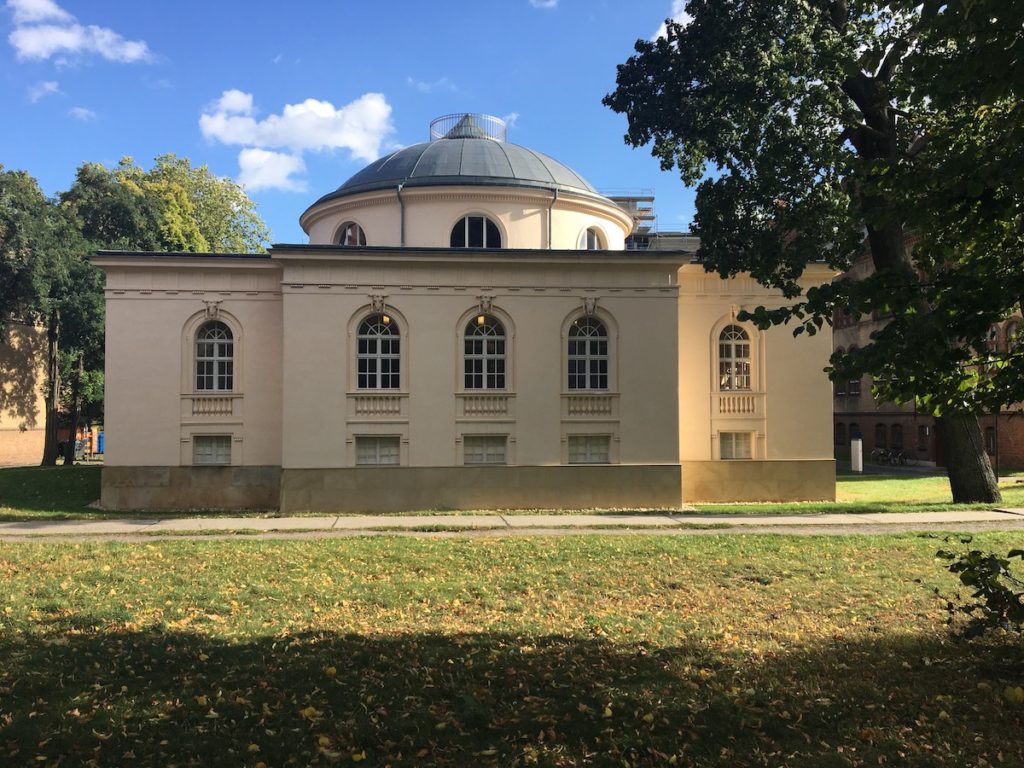
Rode’s frescoes have been extensively repainted as part of the building’s restoration, but the theater as a whole remains essentially true to Rode and Langhans’ initial design.[16] Atrompe l’oeil garland hangs over the windows and is held aloft by human figures and bull skulls (bucrania), forming a continuous circle around the dome. The separate painted panels, punctuated by Palladian windows on each side, are thus united into a composite program. The bucranium perched atop the center of each window references a common architectural element in Doric entablatures, alluding to ancient Greco-Roman sacrificial rituals. Andrea Palladio also incorporated bucrania into his revival of the Doric order, serving as a direct inspiration to Langhans, who designed the theater with Palladio’s Villa Rotonda (1566-1567) in mind (Fig. 5).[17]
The subjects, including boars, dogs, cows, sheep and goats, indicate the comparatively wide range of livestock served by the Tierarzneischule, while the two panels depicting cavalry horses speak to their continued centrality to veterinary science. The men, doubling as caretakers and atlases (the male equivalent of caryatids) present a more or less homogenous range of bodies. Traditional attributes of masculinity, including beards and exaggerated musculature, are on full display, save for the genitalia, which remain decorously covered by drapery as well as various weapons and farming implements. The generic representation of humanity is thus strapping, male and engaged in manual labor, with not a single woman to be found.
Despite their evident strength, the atlases seem overwhelmed by the quantity and energy of the animals. Dogs lick their faces, boars laconically pile themselves at their feet, cattle and horses crowd them to the margins of the panels. The corporeal excess of these figures is further distorted by the curvilinear surface on which they are painted. Human hips and cow heads bulge outwards towards the viewer. Necks and limbs are elongated. The men exceed their allotted panels, arms, legs and drapery spilling onto the window frames. The distortions suggest a seeming lack of internal structure, a boneless malleability. The dead and dissected animal bodies that provoked so much disgust in the Tierarzneischule’scritics are neither directly portrayed nor implied in the frescoes, apart from the bucrania and the clubbed cow at the foot of the bovine plague scene (Fig. 3). In this panel another cow sways in its death throes alongside the prostrate animal. The stolid, Herculean bulk and firmly planted feet of the bearded men who enclose the cattle exert a gravitational pull on the elevated scene. These are not heavenly bodies; the men are weighted down by their labors as much as the animals are by their illness.
Across the frescoes, bodily containment, as well as anatomical accuracy and legibility, are perpetually compromised by the sheer size and number of the painted figures. Organisms lose their individuality in a space devoted to the investigation of their singular forms. The grisaille style, meant to mimic the appearance of relief sculpture, places the images at an even further remove from the room’s purported function of scientifically examining corporeal specimens. The paintings provide the illusion not of colorful animal bodies, but rather of paintings imitating sculptures imitating artworks of the classical past. Any distinctions of breed or individual form are elided by the gray tones and broadness of Rode’s style. The animals are representationally distanced from the mundane, rural sphere to which they were typically consigned, entering the realm of Roman temple sculpture and Christian ceiling painting. The animals thereby move into an allegorical register, functioning as ideal types, in a manner similar to their classically nude human guardians.
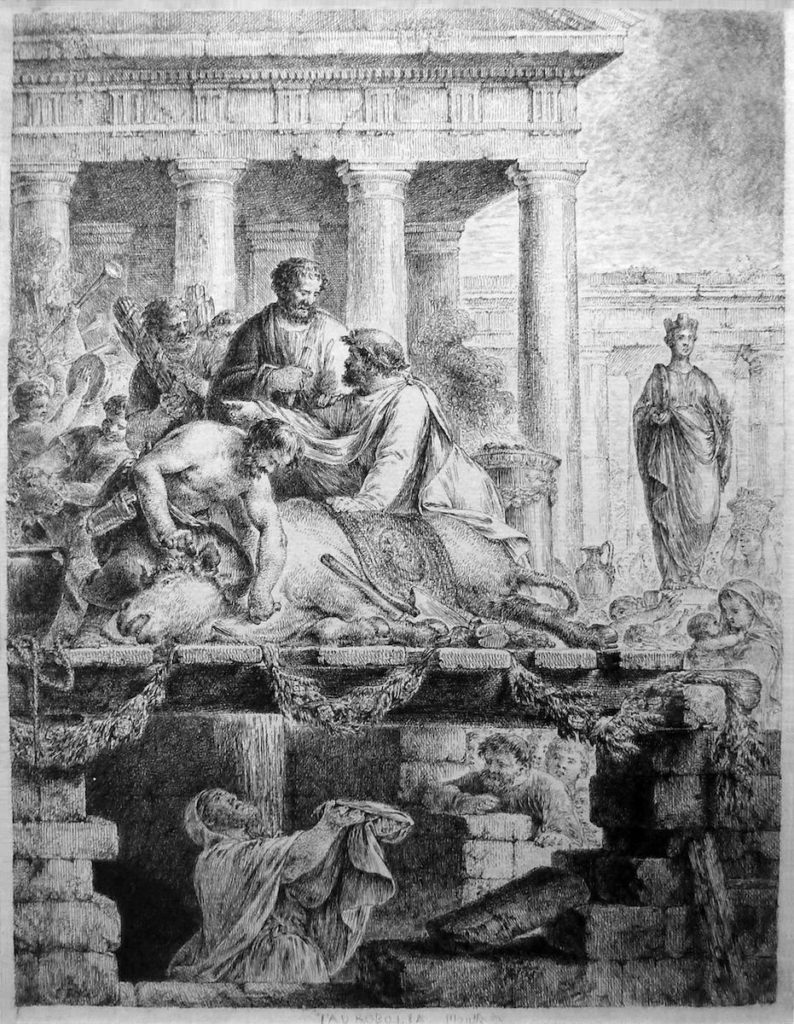
These animal subjects furthermore possessed an ethical dimension for Rode. As a member of the Berlin Enlightenment circle, he contributed to an emerging genre of history paintings and etchings known as “Moral-und Sittenstücke:” moral subjects that presented the viewer with guidelines for an ethically exemplary life guided by reason. Though few of his paintings survive, the artist’s etchings repeatedly return to certain creaturely themes, including the rectitude of an agricultural life and the brutality of ancient pagan animal sacrifices. In the etching Taurobolium (1780) (Fig. 6), the cow, whose blood baptizes a newly initiated priest into the mystery cult of Cybele, bears a significant resemblance to the dying creature at the bottom of the bovine plague panel. The position of this figure’s head, the curly, tufted mane, small curved horns and tongue-lolled expression make it appear like a less finely detailed version of the steer in Taurobolium as well as a related etching of a sacrifice by King Attalus. In the fresco, the sacrifice of the animal is a reluctant last resort, meant to impede the spread of illness to the rest of the herd. Rather than freely availing themselves of the animal’s spent vital force, the men club it to death to preserve the remaining members of its kind. This killing would in turn protect the financial and material interests of human agriculturists, whose livelihood had been decimated by the spread of the bovine plague in the wake of the Austrian War of Succession (1740-1748) and the Seven Years’ War (1756-1763).[18]
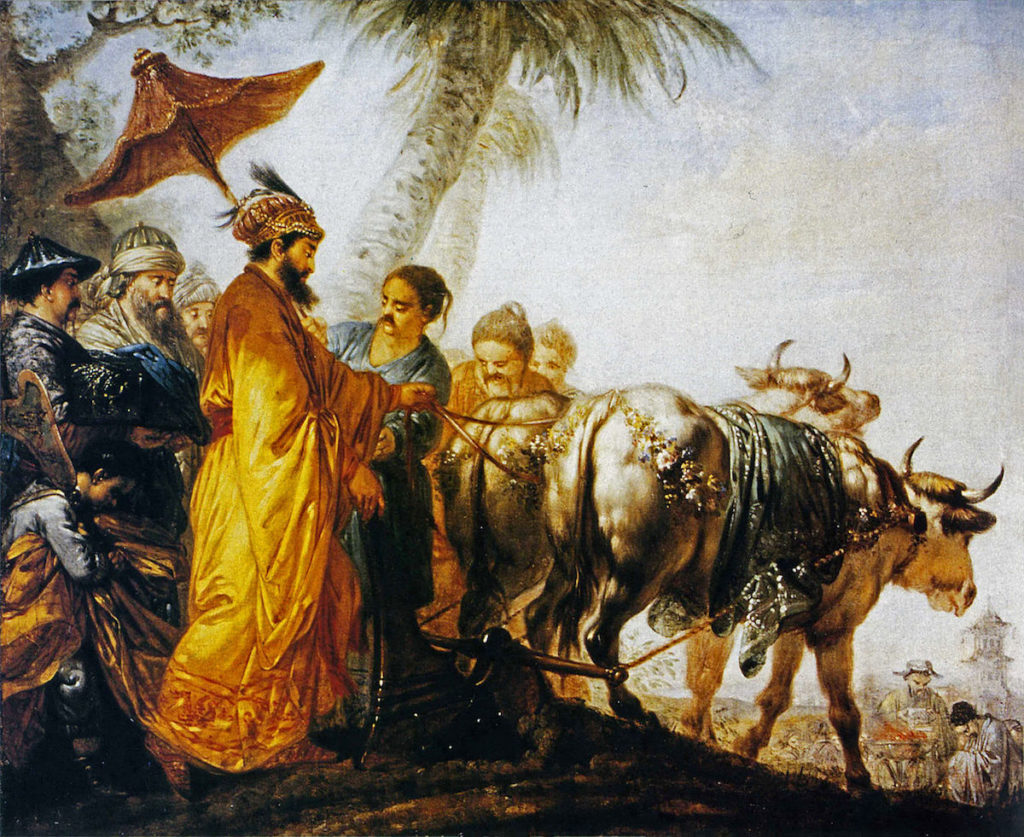
In his oil paintings and etchings of agricultural subjects, Rode favored the trope of rulers and nobility engaged at oxen-drawn plows, participating in practices that might otherwise be considered unsuited to someone of their station. These subjects include a small etching of Cincinnatus being summoned from his farm to serve as Roman dictator during a period of invasion; another etching of Odysseus, king of Ithaca, plowing the fields with his ox; and, most peculiarly, a pair of Orientalized oil paintings depicting the Emperor of China ceremonially working the first furrows of the season in honor of agriculture (Fig. 7) while the Empress plucks mulberry leaves in tribute to silk culture.[19] The maintenance of laboring animals and cultivated fields is presented as the essential basis of the state’s health, wealth, and overall happiness, as guided by the figure of the sovereign. The simultaneously ennobling and humbling nature of agricultural practice is asserted by these images, and is even further emphasized by their contrast with the cruel irrationality exhibited in the pagan animal sacrifices, wherein the spilling of bovine blood appears not only as a wanton waste of life but an uneconomical expenditure of resources. The redeployment of these sacrificial tropes in the Tieranatomisches frescoes honors a more scientifically reasoned disposal of animal bodies. While the sovereign plowing scene does not make an appearance, the respect due to caretakers of the bovine body emerges as one of the theater’s central themes.
The actions of the atlases are similarly framed as protective. They practice a pragmatic violence. The centrality of the lifeless animal form to the architectural space is evoked through ancient sacrificial references that are given a renewed symbolic valence. The animals dissected on the central platform of the anatomical theater have offered up their bodies to the greater good of veterinary medicine. The bloodlessly pure white walls and the elegant ceiling frescoes could thus provide a sense of civic duty to the students ascending the steps of the anatomy theater. Theirs was a practice based neither in ancient superstition nor in the unscientific, lower class labors of the farrier. Even after they turned their backs to the paintings and directed their eyes to the less savory spectacle of livestock bodies being dissected, they would still be enveloped by the neoclassical structure, watched over by allegorical guardians of animal health and husbandry.
Yet Rode’s animals constantly threaten to escape their keepers and the confinement of the fresco panels, effectively taking center stage in conjunction with the animal corpses that once formed the focal point of veterinary students’ attention. The visual predominance of the animal figures, both real and represented, disrupts the insistent symmetry of the spherical theater, as well as the staid, humanistic harmony associated with the Winckelmannian classical ideal. The theater, as a space devoted to the discovery of new knowledge about animal anatomy and epizootic pathogens, acknowledged the precarious nature of domestication and human mastery in its frescoes. With the causes of bovine plague and similar ailments still unknown, creaturely life could not remain fully under human control. While the central animals are dynamic, the humans occupy the same atlas stance at every turn, albeit with varied attitudes and expressions. The painted creatures remain undissected and therefore physically unified, while their unmastered vitality still implies the mysterious internal workings that the anatomy theater sought to unveil. This complication of neoclassical aesthetics through the portrayal of the “lower” species and their equivalence with human bodies presents new potential avenues for the art historical study of corporeal representation in this time period.
Stephanie Triplett is a PhD Candidate at the University of Michigan, Ann Abor, MI and a Chester Dale Fellow at the Center for Advanced Study in the Visual Arts
[1] Helmut Börsch-Supan, Die Deutsche Malerei von Anton Graff bis Hans von Marées, 1760-1870 (Munich:C.H. Beck, Deutscher Kunstverlag, 1988).
[2] Kai Artinger, Von der Tierbude zum Turm der blauen Pferde: die künstlerische Wahrnehumng der wilden Tiere im Zeitalter der zoologischen Gärten (Berlin: Dietrich Reimer Verlag, 1995), 17-19.
[3] Johann Joachim Winckelmann, History of the Art of Antiquity, trans. Harry Francis Mallgrave (Los Angeles: Getty Publications, 2006), 202.
[4] Winckelmann, History of the Art of Antiquity, 193-194.
[5] Marian Mieke, in Tiefe Einblicke: das anatomische Theater im Zeitalter der Aufklärung (Berlin: Kulturverlag Kadmos, 2018), 27-28.
[6] Artinger, Von der Tierbude zum Turm der blauen Pferde, 18-20.
[7] “Protokolle der Sitzungen des Akademischen Senats und Abschriften der Schreiben des Akademischen Senats an das Kultusministerium 1827.” Preussische Akademie der Künste 0075.
[8] Robert Dunlop and David J. Williams, Veterinary Medicine: An Illustrated History (St. Louis: Mosby, 1996), 320-323. See also Michel Ellenberger, L’autre Fragonard (Jupilles: Le Mans, 1981).
[9] Jens-Oliver Kempf, Die Königliche Tierarzneischule in Berlin von Carl Gotthard Langhans: eine baugeschichtliche Gebäudemonographie, 22. Kempf provides an extended analysis of the building’s architectural design throughout his book-length monograph, but only devotes six pages to an analysis of Rode’s painted program.
[10] Kempf, Die Königliche Tierarzneischule, 22.
[11] Kempf, Die Königliche Tierarzneischule, 22.
[12] Kempf, Die Königliche Tierarzneischule, 22-24.
[13] Horst Bredekamp, Die Wissenschaft als Bauherr? Skizzen zur Architekturgeschichte der Humboldt-Universität, 2000,https://edoc.hu-berlin.de/handle/18452/3154 (accessed 1 March 2019).
[14] Kurt Schröder, ed., Veterinärmedizin in Berlin, 1790-1965; Geschichte, Lehre und Forschung heute, der Tierarzt im Sozialismus (Berlin: Humboldt Universität, 1965), 159.
[15]The lecture theater, as well as Rode’s paintings, received mention in Johann Daniel Friedrich Rumpf, Berlin und Potsdam: eine Beschreibung aller Merkwürdigkeiten dieser Städte und ihrer Umgebungen, vol. 2; Almanach zur Kenntnis der Preußischen Staaten für Reisende und Einheimische von 1795 (Berlin: Spener, 1795); and Friedrich Nicolai, Beschreibung einer Reise durch Deutschland und die Schweiz (Berlin and Stettin, Selbstverl., 1796).
[16] Kempf, Die Königliche Tierarzneischule, 183. For a conservatorial perspective on the restoration, see Thomas Wieckhorst, “Tieranatomisches Theater Restaurierung des von Carl Gotthard Langhans entworfenen Tieranatomischen Theaters der Humboldt-Universität in Berlin,” Bauhandwerk (April 2013), https://www.bauhandwerk.de/artikel/bhw_Tieranatomisches_Theater_1628730.html (accessed 5 March 2019).
[17] For further discussion of bucrania and sacrificial motifs in ancient art, see George Hersey, The Lost Meaning of Classical Architecture (Cambridge: MIT Press, 1988).
[18] Kempf, Die Königliche Tierarzneischule, 182.
[19] For a discussion of Rode’s role in Enlightenment German circles, see Frank Büttner, ed., Kunst im Dienste der Aufklärung: Radierungen von Bernhard Rode 1725-1797 (Kiel: Jens Christian Jensen, 1986).
Cite this note as: Stephanie Triplett, “Creaturely Classicism in Bernhard Rode’s Tieranatomisches Theater Frescoes,” Journal18, Issue 7 Animals (Spring 2019), https://www.journal18.org/3808.
Licence: CC BY-NC
Journal18 is published under a Creative Commons CC BY-NC International 4.0 license. Use of any content published in Journal18 must be for non-commercial purposes and appropriate credit must be given to the author of the content. Details for appropriate citation appear above.
